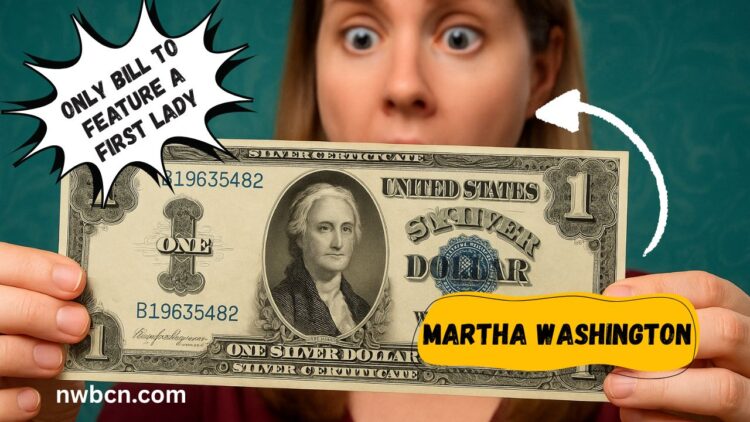In 1886, the U.S. Treasury introduced the Series of 1886 $1 Silver Certificate, marking the first time a real woman—Martha Washington—was depicted on Federal paper currency. Taking center stage on the obverse, this historic note became the first and only U.S. paper currency to feature a First Lady in a primary portrait role, a distinction unmatched in nearly 140 years.
Historical Context and Meaning
Why Martha Washington?
- A national symbol: As George Washington’s wife and the first informal First Lady, Martha Washington embodied early American values and leadership.
- Treasury vision: When designing the new $1 certificate, the Bureau of Engraving selected Martha’s portrait to symbolize reverence and unity in a post–Civil War America.
- Public enthusiasm: Newspapers across the nation praised the move as refreshing and symbolic of the nation’s admiration for “the Mother of our Country” .
Design and Production
- Obverse image: The vignette draws from a Charles Jalabert painting, engraved by an unknown artist.
- Red Treasury seal: Prominently placed beside the portrait.
- Series and revisions:
- First issued: Fall 1886.
- Second run: Series of 1891 featured a slightly updated engraving of Martha; both retain her portrait.
- Silver Certificate backing: These notes were redeemable for one silver dollar and part of a larger program running from 1878 to 1964.
1886 vs 1891 Martha Washington Notes
| Feature | 1886 Series | 1891 Series |
|---|---|---|
| Portrait | Martha Washington (Charles Jalabert style) | Refined engraving based on 1886 design |
| Treasury Seal Color | Red | Red |
| Silver Certificate | Backed by silver dollar | Same backing |
| Public Release | Fall 1886 | Early 1891 |
| Rarity & Collectibility | Highly prized, first-ever female figure | Similarly prized, slightly rarer |
| Historical Significance | First and only note featuring a First Lady | Reaffirmed significance with redesign |
Why It Has Never Been Repeated
- Traditional male subjects: U.S. currency portraits have predominantly featured presidents, founding fathers, and allegorical figures—men.
- Cultural norms: In the late 19th century, high-visibility images of women on money were rare; the Martha note was an exception.
- Design standardization: After 1891, silver certificates transitioned to more utility-based designs with minimal portraits, and no new $1 note featured a First Lady.
- End of silver certificates: By 1964, the Silver Certificate series ended, and subsequent designs featured George Washington again, maintaining tradition.
Collector Value & Market Trends
| Condition Grade | Market Value Range |
|---|---|
| Circulated (VG–VF) | $250–$600 |
| Extremely Fine (XF) | $600–$1,200 |
| About Uncirculated | $1,500–$3,000 |
| Certified AU–MS60 | $3,500–$7,500 |
| High-Grade MS63+ | $7,500–$15,000+ |
- 1886 notes generally hold slightly higher value than 1891 notes due to being the original release.
- Certification by PMG or PCGS significantly boosts value and reassurance.
- Notes with extraordinary eye appeal, wide margins, bright colors, and bold engraving command premium prices.
Historic Reactions and Cultural Impact
In 1886, public and media reception was overwhelmingly positive:
- Indiana Democrat (Feb 1901): Owners ‘‘have an excellent picture of Martha Washington’’.
- Atlanta Constitution (Oct 1886): Described Martha notes as ‘‘very pretty’’ and the first female-featured currency.
- Despite some period critiques regarding artistic embellishment, the design resonated with a broad audience .
Why Collectors Covet This Note
- Singular historical first – Only U.S. currency to spotlight a real First Lady prominently.
- Artistic rarity – Designed during a creatively vibrant era of Silver Certificates.
- Cultural resonance – Signals early recognition of women’s roles in American history.
- Limited survival – Most circulated notes deteriorated; quality examples are rare.
- Solid investment – High-grade specimens have shown consistent value appreciation.
Preservation Advice for Owners
- Use inert currency sleeves or PMG/PCGS holders to prevent damage and maintain certification.
- Avoid excessive light exposure, as red seals and ink can fade over time.
- Control storage conditions—cool, stable humidity helps preserve paper integrity.
- Document provenance, as linking your note to earlier collections or sales enhances value.
The 1886 Martha Washington $1 Silver Certificate stands as a trailblazing piece of American currency history, the only U.S. note to feature a First Lady in a primary portrait role.
Representing a unique fusion of artistry, cultural homage, and numismatic rarity, these notes remain top-tier collectibles—especially in uncirculated, certified form.
Nearly 140 years after their debut, Martha Washington’s likeness continues to captivate collectors and historians alike.
FAQs
Q1: Are there any other U.S. bills featuring First Ladies?
No. Besides Martha Washington’s silver certificates (1886 & 1891), no other real First Lady has appeared prominently on U.S. currency.
Q2: Which is more valuable—the 1886 or 1891 note?
Typically, 1886 specimens fetch a modest premium since they represent the original series, though both are highly sought-after.
Q3: How do I verify authenticity and value?
Have the note graded by reputable services like PMG or PCGS. High-grade certifications, evident condition, and intact red seals significantly increase collectibility and value.
